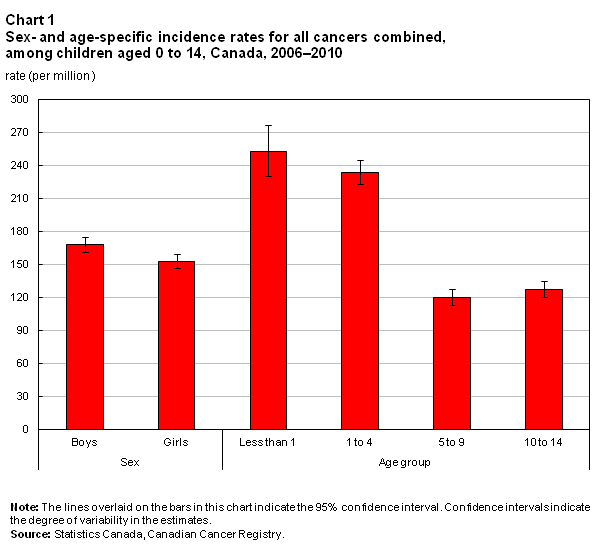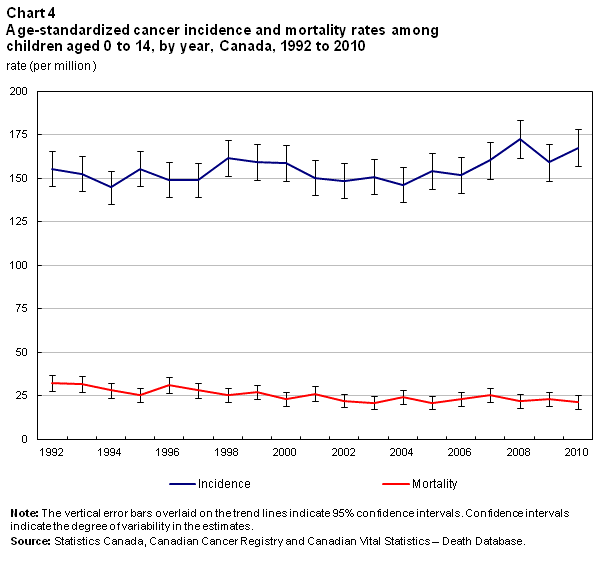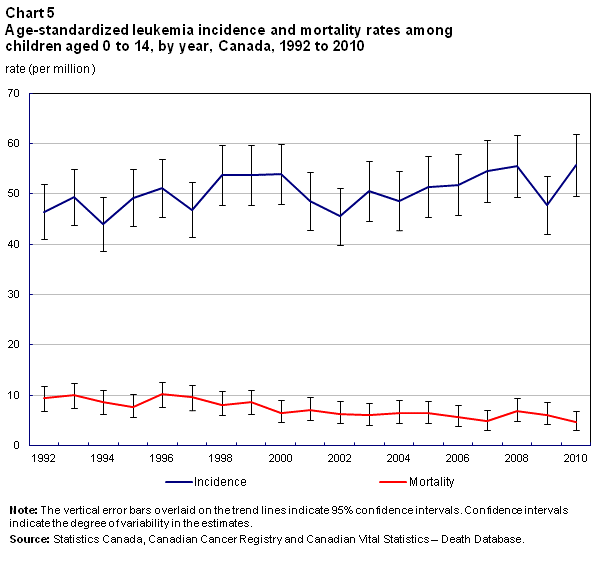Health at a Glance
Archived Content
Information identified as archived is provided for reference, research or recordkeeping purposes. It is not subject to the Government of Canada Web Standards and has not been altered or updated since it was archived. Please "contact us" to request a format other than those available.

Childhood cancer incidence and mortality in Canada
Statistics Canada Catalogue no. 82-624-X
by Lawrence Ellison and Teresa Janz
- Highlights
- All childhood cancers combined
- Leukemias are the most commonly diagnosed childhood cancer group
- Incidence rates higher in boys and younger children
- Lymphomas and leukemias are diagnosed more often in boys than girls
- Patterns in the age at diagnosis vary by type of childhood cancer
- Central nervous system (CNS) tumours are the most common cancer-related cause of death in children
- Childhood cancer mortality decreasing over time from 1992 to 2010; incidence slowly increasing
- Childhood leukemia mortality decreasing over time; incidence slowly increasing
- Childhood lymphoma mortality decreasing
- Summary
- Data source, methods and definitions
- References and notes
- Related material for this article
Start of text box
Highlights
- During the 2006-2010 period, children under age 15 were diagnosed with cancer at a rate of 161 new cases per million children, per year, and cancer caused 23 deaths per million, per year.
- The most commonly diagnosed childhood cancer groups in 2006-2010 were leukemias (32%), central nervous system tumours (19%) and lymphomas (11%).
- The rate of cancer diagnosis was 10% higher in boys than girls.
- In 2006-2010, the rate at which cancer was diagnosed before the age of 5 was almost twice the rate it was diagnosed between the ages of 5 and 14.
- Between 1992 and 2010, the rate of newly diagnosed cases of childhood cancer increased by an average of 0.4% per year, while the rate of cancer deaths in childhood decreased by an average of 2.0% per year.
- For leukemias, there was a 0.6% average increase per year in the rate of new cases from 1992 to 2010, and a 3.5% average decrease per year in the rate of deaths.
End of text box
Cancer is the second leading cause of death in Canadian childrenNote 1(after accidents), and it is the leading cause of death when just considering diseases.Note 2,Note 3
Although childhood cancer is relatively rare compared with cancer in adults, for many children the effects can last a lifetime as a result of the cancer itself and/or from the treatment.Note 4,Note 5 Additionally, childhood cancer can cause emotional and financial strain on the entire family.Note 6,Note 7
Another distinction is that the types of cancers that tend to develop in children differ from the types common to adults.Note 8 Adults are more likely to be diagnosed with breast, lung, prostate and colorectal cancer, but these are very rare in children. Children are more likely to be diagnosed with cancers of the blood and lymphatic system, such as leukemia. Because of the differences, analyses of childhood cancer typically use cancer groups that differ from the ones relevant to adults.
This article presents national data on the number of newly diagnosed cases of childhood cancer (incidence) and the number of deaths attributed to cancer (mortality) in children under the age of 15. Incidence data are explored by age, sex and the five most commonly diagnosed groupsNote 9 of childhood cancer. Due to the low number of cancer cases, five years of data, between 2006 and 2010, were combined to report the most recent results.Note 10 These most recent statistics will be reported in this article as rates for the 2006-2010 time period.
The second main contribution of this paper is that it explores trends over time with almost 20 years of data (1992 to 2010) on both incidence and mortality.
The data sources include the Canadian Cancer Registry (1992 to 2010) and the Canadian Vital Statistics – Death Database (1992 to 2010) (see Data sources, methods and definitions text box).
All childhood cancers combined
During 2006–2010, childhood cancer was diagnosed at a rate of 161 new cases per million children, per year (Table 1).Note 11 This rate corresponds to an average of 905 new cases of childhood cancer per year during this time period—about 0.5% of the total number of cancers diagnosed yearly in Canada.
| Cancer group | Average number of cases per year | Annual incidence rate (per million children) | Percent (%) of childhood cancer cases |
|---|---|---|---|
| All cancers | 905 | 161 | 100 |
| Leukemias | 292 | 52 | 32 |
| CNSNote 1 table 1 tumours | 173 | 31 | 19 |
| Lymphomas | 100 | 18 | 11 |
| Neuroblastomas | 71 | 13 | 8 |
| Soft tissue sarcomas | 59 | 10 | 6 |
|
|||
Leukemias are the most commonly diagnosed childhood cancer group
Leukemias were the most commonly diagnosed cancer, accounting for 32% of all childhood cancers. Leukemias are cancers of the blood cells that do not behave normally and grow uncontrollably. There are many different types of leukemia that are classified depending on the type of blood they develop from, and how fast they grow.Note 12
Cancers of the central nervous system (CNS) were the second most commonly diagnosed childhood cancer group (19%). CNS tumours begin when normal cells in the brain or the spinal cord change and grow uncontrollably, forming a mass.
The third most commonly diagnosed group of childhood cancers were lymphomas (11%). Lymphomas begin when cells in the lymphatic system (a system of the body responsible for fighting infection or other diseases) change and grow uncontrollably. As lymph tissue is found in many parts of the body, including lymph nodes, skin, stomach, intestines and other organs, lymphomas can originate almost anywhere.
Neuroblastomas (8%) were the fourth most common group. A neuroblastoma is a solid cancerous tumour that begins in the nerve cells. It most often begins in the adrenal glands, but it can also develop in other areas of the abdomen and in the chest, in the neck, and near the spine.
Soft tissue sarcomas, the fifth most common childhood cancer group, represented 6% of the cancer cases. These are cancers that develop in the tissues that support and connect the body (for example, muscles, nerves and tendons).
Together, the five most commonly diagnosed cancer groups represent almost three-quarters of all new childhood cancers cases.
Incidence rates higher in boys and younger children
For all newly diagnosed childhood cancers combined during 2006–2010, the rate among boys was 10% higher than the corresponding rate among girls (Chart 1).Note 13,Note 14
During the same time period, cancer was diagnosed at almost twice the rate among children younger than age 5 (238 per million, per year), than among those between 5 and 14 years old (124 per million, per year).

Lymphomas and leukemias are diagnosed more often in boys than girls
Considering specific cancer groups, the rate of diagnosis for lymphoma was 80% higher in boys than girls; for leukemias it was 18% higher in boys (Chart 2). There were no significant differences between boys and girls in the rate of diagnosis of: CNS tumours, neuroblastomas and soft tissue sarcomas.

Patterns in the age at diagnosis vary by type of childhood cancer
Patterns in the age at diagnosis varied among the childhood cancer groups (Chart 3). For both leukemias and CNS tumours, incidence rates in the 2006–2010 time period were highest in the 1 to 4 year-old age group and lowest among those aged 10 to 14. The annual rate of leukemias in the 1 to 4 year-old age group (99 per million) was double the rate in any other age group.
Incidence rates of lymphomas increased with age. The rate among children aged 10 to 14 (27 new cases per million, per year) was approximately 5 times the rate for those under the age of 1.
The annual rate of new cases of neuroblastomas declined with age from 68 per million in the first year of life to 24 per million among those aged 1 to 4 and, ultimately, to 1 per million for those aged 10 to 14.
The rate of incidence of soft tissue sarcomas was also highest before the age of 1 (19 per million per year). The rate of diagnosis in the first year of life was about twice the rate for ages 1 to 14 combined.

Central nervous system (CNS) tumours are the most common cancer-related cause of death in children
During the 2006–2010 period, one in three deaths due to cancer in children was from a CNS tumour, and almost one in four was from leukemia (data not shown). Overall, an average of 129 children under the age of 15 died each year from cancer. This figure corresponds to an annual mortality rate of 23 per million children.
Childhood cancer mortality decreasing over time from 1992 to 2010; incidence slowly increasing
In order to assess the change over time, data between 1992 and 2010 were examined. It was noted that the childhood cancer mortality rate decreased by an average of 2.0% per year (Chart 4), while the incidence rate increased by an average of 0.4% annually (Chart 4 and Table 2).Note 15,Note 16,Note 17
The overall pattern of increasing incidence rates differed somewhat between boys and girls. Among boys, the rate increased by an average of 0.5% per year. Among girls, a 3.1% average annual increase was observed between 2004 and 2010, whereas from 1992 to 2004 there was no significant change in the rate.

Childhood leukemia mortality decreasing over time; incidence slowly increasing
Between 1992 and 2010, the mortality rate for leukemia decreased by an average of 3.5% per year (Chart 5), while the incidence rate for this cancer increased by an average of 0.6% annually (Chart 5 and Table 2). The rate of diagnosis of new cases of leukemia increased among boys (0.8% per year). However, there was no significant change in the rate among girls (Table 2).

| Cancer group | Sex | ||
|---|---|---|---|
| Both | Males | Females | |
| All cancers | 0.4Note * | 0.5Note * | 0.5Note † |
| Leukemias | 0.6Note * | 0.8Note * | 0.4 |
| Lymphomas | 0.5 | 0.5 | 0.3 |
| CNSNote 1 table 2 tumours | 0.1 | 0.1 | -0.1 |
| Neuroblastomas | 0.7 | 1.4Note * | 0.0 |
| Soft tissue sarcomas | -0.1 | -1.0 | 0.9 |
Source: Statistics Canada, Canadian Cancer Registry. |
|||
Childhood lymphoma mortality decreasing
While there was no significant change in the incidence rate of lymphomas between 1992 and 2010 (Chart 6 and Table 2), the mortality rate for this group of cancers decreased by an average of 4.5% per year during this period (Chart 6). It is important to consider, however, that lymphoma deaths during childhood were already exceedingly rare in the early 1990s.
There were no significant changes over time in the incidence rates of CNS tumours, neuroblastomas or soft tissue sarcomas between 1992 and 2010Note 18 with one exception: the incidence rate of neuroblastomas, among boys, increased by an average of 1.4% per year.

Summary
During the 2006–2010 period, cancer in children was diagnosed at an annual rate of 161 cases per million children. The annual mortality rate was 23 deaths per million children. Leukemias were the most commonly diagnosed childhood cancer group, accounting for 32% of all cancer cases in children. The rate of diagnosis for all cancers combined was 10% higher in boys than girls, overall, and 80% higher specifically for lymphoma. The rate at which cancer was diagnosed before the age of 5 was almost twice the rate it was diagnosed between the ages of 5 and 14.
Between 1992 and 2010, the rate of newly diagnosed cases of childhood cancer increased by an average of 0.4% per year, while the rate of cancer deaths in childhood decreased by an average of 2.0% per year.
Start of text box
Data sources, methods and definitions
Data sources
Canadian Cancer Registry is a dynamic, person-oriented, population-based database maintained by Statistics Canada. It contains information on cases diagnosed from 1992 onward, compiled from reports from every provincial and territorial cancer registry in Canada. Cancer incidence data in this report are from the final tabulation master file released February 3, 2014.Note 19 The analysis file was created using the multiple primary coding rules of the International Agency for Research on Cancer.Note 20 Cases were defined based on the International Classification of Diseases for Oncology, Third Edition.Note 21
Canadian Vital Statistics – Death Database includes demographic and cause of death information for all deaths from all provincial and territorial vital statistics registries in Canada. Prior to 2010, some data were collected on Canadian residents who died in some American states; these deaths were excluded from this analysis. Starting with the 2010 reference year, data on Canadian residents who died in American states are no longer collected.
Methods: Classification of cases and deaths
Cancer cases were classified using an updated version of the third edition of the International Classification of Childhood Cancer (ICCC-3).Note 22,Note 23,Note 24,Note 25 This system groups similar cancers into 12 major diagnostic groups and subgroups for additional refinement. For simplicity, only the five most frequently diagnosed groups were included in this report.
Deaths were classified using the World Health Organization’s International Statistical Classification of Diseases and Related Health Problems—10th Revision (ICD-10)Note 26 for deaths from the year 2000 onward, and the 9th Revision (ICD-9)Note 27 for deaths from previous years.Note 28 The definitions of specific cancer types differ between ICCC-3 and ICD-9/ICD-10. The categories are similar for the leukemias and lymphomas, but, for solid tumours, the categories can be quite different.
Definitions
For ease of communication, abbreviated names have been used throughout the text to represent the following childhood cancer groups:
| Leukemias | Leukemias, myeloproliferative diseases, and myelodysplastic diseases |
|---|---|
| Lymphomas | Lymphomas and reticuloendothelial neoplasms |
| Central nervous system (CNS) tumours | Central nervous system and miscellaneous intracranial and intraspinal neoplasms |
| Neuroblastomas | Neuroblastoma and other peripheral nervous cell tumours |
| Soft tissue sarcomas | Soft tissue and other extraosseous sarcomas |
End of text box
Lawrence Ellison and Teresa Janz are analysts with the Health Statistics Division.
References and notes
Additional information
- For more statistics and analysis on the health of Canadians and the health care system, visit the Health in Canada module. This module is accessible from our website, under Features.
Related Articles
Bibliographic references
- Date modified:
